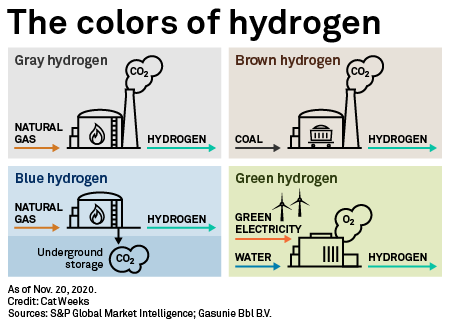Mitsubishi Power Americas Inc. and infrastructure development company Bakken Energy LLC announced a project to establish a North Dakota blue hydrogen hub, marking Mitsubishi's latest partnership in a campaign to develop hydrogen clusters throughout the U.S.
Under the strategic partnership, the companies will seek to develop assets to produce, store and transport blue hydrogen alongside facilities that would consume the low-carbon fuel, according to a June 2 press release. The partners also envision building pipelines to connect the North Dakota hub to other North American hydrogen clusters.
As part of the plan, Bakken Energy, formerly Bakken Midstream Natural Gas LLC, is seeking to acquire the Great Plains Synfuels plant from Dakota Gasification Co. Inc., a subsidiary of Basin Electric Power Cooperative. Bakken Energy and Mitsubishi Power intended to redevelop the facility into the largest clean hydrogen production facility in North America.

The facility near Beulah, N.D., currently operates as a commercial-scale coal gasification plant and utilizes technology to capture, compress and transport carbon dioxide from the gasification process. Blue hydrogen producers pair steam methane reforming, the most widely used method for making hydrogen, with carbon capture and storage technology. Natural gas is typically the feedstock for steam methane reforming.
Bakken Energy launched as Bakken Midstream Natural Gas in 2019 to develop infrastructure and attract industries that make value-added natural gas products to North Dakota, according to Williston Herald articles at the time. The idea was to utilize the state's gas resources for economic development, rather than flaring them during shale oil production. The company has since gravitated to hydrogen opportunities amid a surge in interest in the fuel.
"Blue hydrogen represents a huge opportunity for synergies with our existing energy development, and these are exactly the innovative strategies that will bring North Dakota one step closer to being carbon neutral by 2030 with an all-of-the-above energy approach," North Dakota Gov. Doug Burgum said in the press release.
Many industry observers have said they see blue hydrogen playing a key role in the so-called hydrogen economy, particularly in its early years as zero-carbon green hydrogen produced with renewable electricity scales up. The International Energy Agency's roadmap to a net-zero world, released in May, saw blue hydrogen accounting for nearly 40% of global hydrogen consumption in 2050, driving half of global natural gas demand at mid-century.
Alberta is also vying to become a blue hydrogen hub. The U.S. Gulf Coast, home to much of the nation's existing hydrogen production and infrastructure, has been identified as a potential blue hydrogen hub.
In the North Dakota project, it is not clear when or how the network of long-haul hydrogen pipelines would emerge, but Mitsubishi, which develops hydrogen-compatible turbines for power generation, is involved in several hydrogen clusters in the U.S. The projects include a recently launched effort to develop the nation's first green hydrogen hub in Los Angeles, anchored by several gas-fired power plant conversions. Mitsubishi is also supplying turbines to the Intermountain Power project, which will convert a coal-fired power plant in Delta, Utah, to a facility that runs on a blend of natural gas and hydrogen.
In May, the company agreed to develop large-scale hydrogen storage solutions with Texas Brine Co. LLC, a Houston-based company that holds positions in salt deposits in Massachusetts, Virginia, Louisiana and Texas. Access to utility-scale storage like salt caverns is critical to viable hydrogen hubs.
Bakken Energy's efforts in North Dakota energy resources have involved salt cavern storage and next-generation power plants, North Dakota Lt. Gov. Brent Sanford said in the press release.



